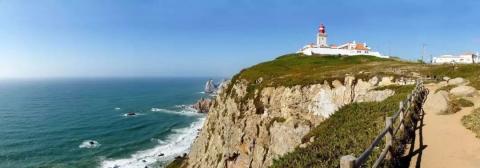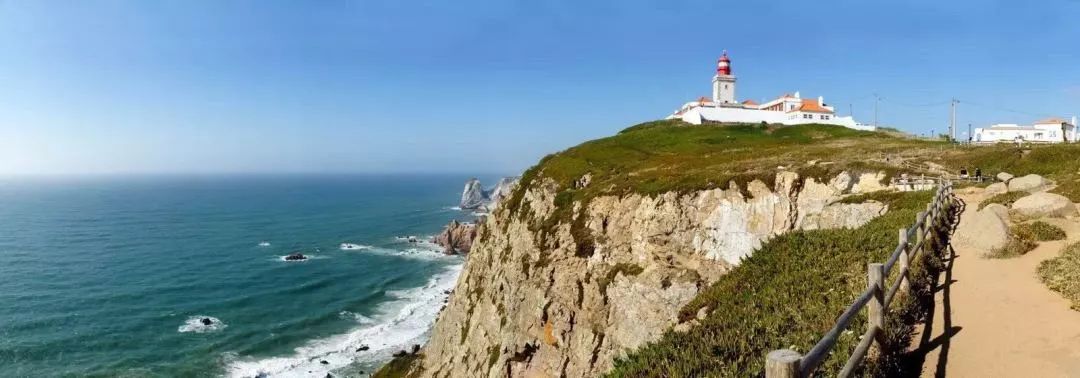

DAY7
ends of the earth
Location
Portugal
Dear Lin'an:
Today, we are going to the ends of the earth in Eurasia.
In addition to the beautiful Lisbon, Portugal also has a little-known but one of the famous monuments - Cabo da Roca.
Cabo da Roca is a promontory adjacent to the Atlantic Ocean, about 140 meters high and only 40 kilometers away from Lisbon. It is located at the westernmost point of Portugal and the entire Europe. People can stand on it and look out at the 'Green Sea of Death' - the Atlantic Ocean. Earlier, people had built a lighthouse and a monument on it, with a cross facing the sea placed on the monument. These are the only signs of Cabo da Roca. A famous saying is engraved in front of the monument: "The land ends here and the sea begins here." ]

Pena Palace
Cabo da Roca’s [neighbor] is Palazzo Pena. It was the summer resort of the old Portuguese dynasty. Looking from the Pena Palace, you can vaguely see the foggy and rolling blue Atlantic Ocean, as well as the tall monuments. The wind blowing from there seemed to be leading us to the [Green Sea of Death]...
Why is the Atlantic Ocean called the "Green Sea of Death"?
During the 12th and 13th centuries, European navigation technology was very weak. Because the water near the coast of the Atlantic Ocean appears green, and people at that time believed that the weather changes in the Atlantic Ocean were unpredictable and the wind and waves were dangerous, so they could only look at the ocean and sigh, which gave the Atlantic Ocean such a name.
Standing on the solid rock, we saw a strange scenery: fog began to appear on the sea, and at first it was as thin as a gauze covering the ocean; as time went by, the mist began to accumulate, and the Atlantic Ocean became increasingly blurry in our sight. ; Finally, the fog is like a cloud falling into the world, covering the entire ocean - no, it is better to say it is protecting, because we can hardly see the rolling blue waves, instead they are under the cliff. The vast white area that was stopped seemed to want to enjoy the beautiful scenery alone without letting others feast their eyes. So, we enjoyed the performance that the fog brought to us with great interest: layers of fog rolling like a sea of clouds, dancing like a sea of flowers, flying like a sea of trees, and rushing like a sea of fire.
But in the end, the Atlantic Ocean was unwilling to let this shadow cover itself. It drove away the fog and continued to be active as if it were alive again. There is also a nostalgic fog that is unwilling to recede - under the remaining fog, we can see the waves rolling up in the green ocean; and looking at it, the fog seems to disappear into the blue sky, and seems to block the blue sky and clear water At the junction of , we can only know that we saw a real scene of "blending of clouds and sea", and also saw several rocks standing not far away, withstanding the impact of the waves.
I seemed to see a scene from five hundred years ago: the Portuguese stood on the shore and kept thinking: "Can ships sail in the Atlantic Ocean?" Will you reach the east if you keep going west? Are the legendary spices and gold real or fake? ] With the desire for the East, the curiosity about the Atlantic Ocean, and the spirit of exploration of the unknown world, they set sail from the ends of the earth in Europe. Although the Portuguese set sail more than 100 years later than Zheng He, they completely defeated him in courage - Zheng He's fleet was vast, while the Portuguese (and Spanish) fleet only consisted of three broken sailing ships. The final outcome was of course that the Portuguese arrived in the East (otherwise how could they seize the right to live in Macau), but the process of all this was tragic and tragic.
After visiting the historic and majestic Cabo da Roca, we took a short rest and then set off to Portugal’s beautiful summer palace, Sintra Palace.
As we all know, the Summer Palace is the summer palace of China, and Schönbrunn Palace is the summer palace of Austria—even Portugal, a small European country, has a world-famous summer palace.

sintra palace
Sintra Palace was the brainchild of King Ferdinand of Portugal in the 19th century. Inspired by German Romanticism, Ferdinand had German architects build the palace; unfortunately, Ferdinand died just as Sintra Palace was being completed. Sintra became the center of European Romantic architecture.
The pure white outer walls of the Sintra Palace reflect the sun's rays, which makes people feel dazzling. At the same time, they feel that the light is coming from the palace itself, which makes them admire it even more. The walls inside the palace looked a bit old and worn because they had gone through too many vicissitudes of life, but the blue tiles carved with flowers still showed a brand new look. The pool in the center of the room also looks very desolate, but it stands proudly like wintersweet that has experienced the cold winter.
The narrow clockwise spiral staircase looks weird and out of place in the huge palace. The slightly brown staircase goes around in a circle, making us unable to see the end point. However, when we finish walking this staircase, we will find that we have a feeling of "there is no way out after mountains and rivers, and there is a village with dark flowers and bright flowers".
Sintra Palace is famous for its Swan Room. The Swan Hall is the main palace of King Ferdinand - he once ordered the architect to paint the ceiling of the main palace with swans of various shapes. Each swan has a crown hanging upside down from its long neck. The entire ceiling is occupied by a flock of lifelike swans. We can also find a statue of a swan inside the main hall - although it is a statue similar to a figure. Each statue is painted a different color, and each color contains a national style.

china palace
The most amazing thing is a specially carved out piece of land in the Sintra Palace - the Chinese Room. The antique and gorgeous hall, with Chinese artistic sculptures inlaid on the ceiling and walls, does not make people feel disharmonious. The pavilions and pavilions are carved from white jade. Among these exquisite works of art, there are also some miracles - a seven-story pavilion leaning slightly to one side like the Leaning Tower of Pisa, but it is supported by an unknown force and does not fall down.
In the simple and gorgeous Chinese Hall, the largest art piece is the ancient Fenyang Palace. Going up the stairs, an ancient pavilion appeared in front of you. The doors are open, and there is a jade-carved lantern hanging on each door. Its appearance is so lifelike that only a beam of light is missing; two people in buns stand on the platforms on both sides, as if to welcome us; further down, Walking a little further, a vague shadow like a god's statue appeared in front of us; when we raised our heads, we could see an eye-catching sign with the three characters "King of Fenyang" written on it; and the attic above could be called "King of Fenyang". Carved beams and painted buildings]: Two couplets are engraved on the pillars at the front, each word is about the size of a mosquito's foot; the four gold-painted pillars at the back reflect the sun's rays; the railings and the dreamy top are clearly visible. In the small buildings on both sides, you can clearly see the activities of several people: some are waving, some are chatting with someone, and some are admiring the scenery... You can also see the water splashing on the top of the pavilion. And the [sun] that is shining and heating.
Today’s theme color will be [green] based on the color of the Atlantic Ocean we saw this morning.
Some pictures come from the Internet. If there are any copyright issues, please contact the author to delete them.
